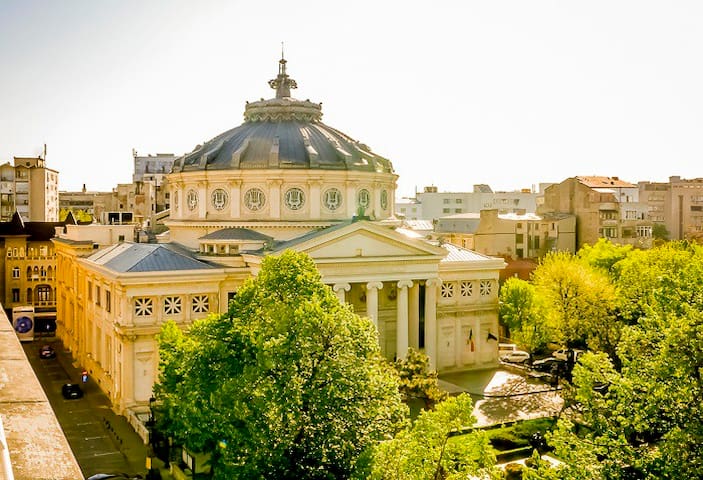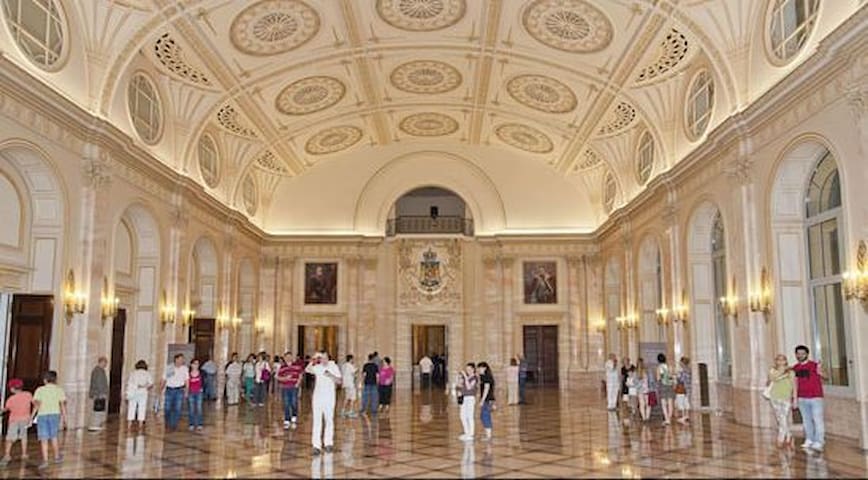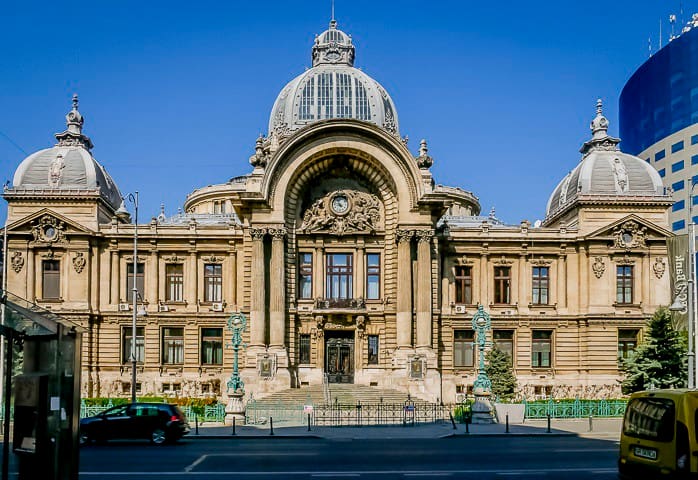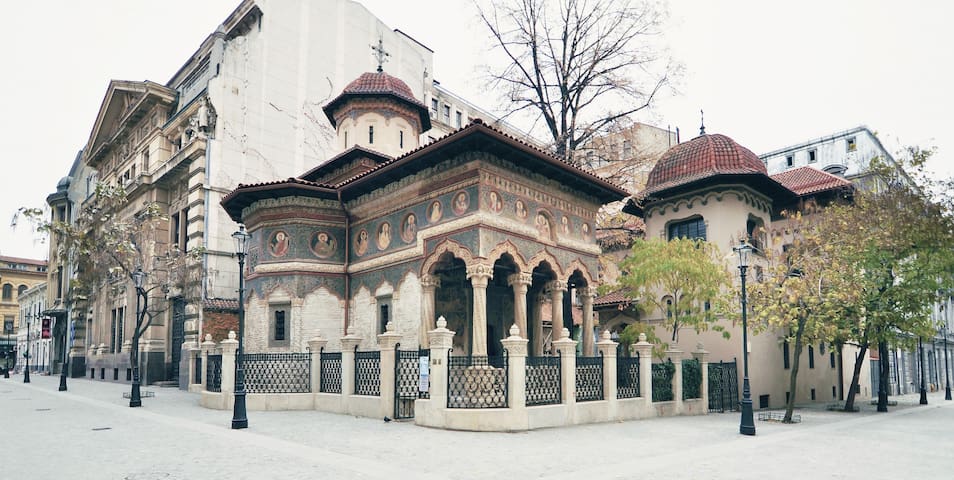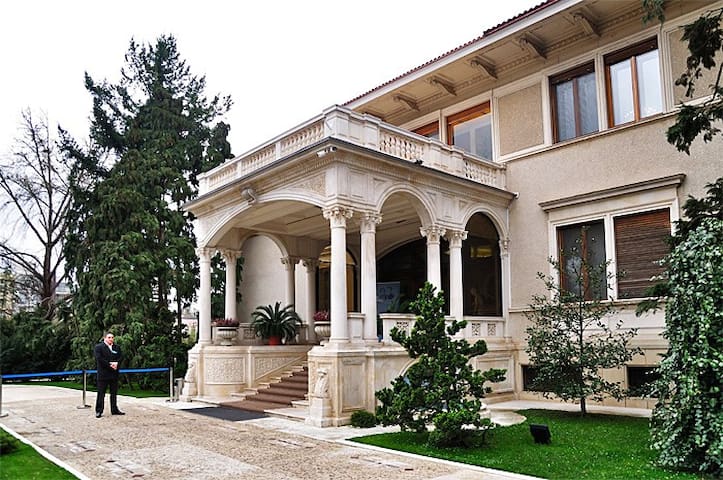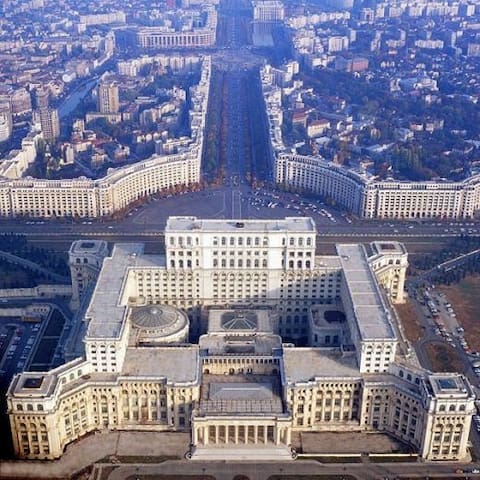Sightseeing
Do you have just a day to see Bucharest, capital of Romania? It has a rich and diverse history and has so much to offer to an inquisitive traveller. Here is a selection of things to do in Bucharest for you also to enjoy. If you have more time, make it slower and deeper in two days.
Romanian Athenaeum is a concert hall built at the end of 19th century by the French architect Albert Galleron. It is of the Bucharest’s symbols, the most prestigious concert hall of the capital and one of the most beautiful buildings in the city. This unique historical monument is the headquarters of the George Enescu Philharmonic Orchestra. The Athenaeum interior is even more impressive than its exterior: four Carrera marble spiral stairs, an arch decorated with medallions depicting various sciences, organ realized at the George Enescu's proposal and the concert hall adorned with amazing frescoes. So if you have more time, take an opportunity to see it also from inside or even better to attend a concert there and enjoy its world-famous acoustics. In 2007 Romanian Athenaeum was included into the European Heritage List for its historical importance to Europe and the EU.
333 personas locales recomiendan
Romanian Athenaeum
1-3 Strada Benjamin FranklinRomanian Athenaeum is a concert hall built at the end of 19th century by the French architect Albert Galleron. It is of the Bucharest’s symbols, the most prestigious concert hall of the capital and one of the most beautiful buildings in the city. This unique historical monument is the headquarters of the George Enescu Philharmonic Orchestra. The Athenaeum interior is even more impressive than its exterior: four Carrera marble spiral stairs, an arch decorated with medallions depicting various sciences, organ realized at the George Enescu's proposal and the concert hall adorned with amazing frescoes. So if you have more time, take an opportunity to see it also from inside or even better to attend a concert there and enjoy its world-famous acoustics. In 2007 Romanian Athenaeum was included into the European Heritage List for its historical importance to Europe and the EU.
Royal Palace was built extending a former boyar house used by rulers of Romania by adding two wings to it in the late 19th century to be representative enough for Carol I the new king of Romania. Palace was rebuilt in the late 1930s after fire by King Carol II. In December 1947, the monarchy was abolished in Romania and the last king Michael left his country and the Palace. Today, the former Royal Palace houses the valuable National Art Museum, with a particularly interesting section of Medieval Art.
24 personas locales recomiendan
Royal Palace of Bucharest
49-53 Calea VictorieiRoyal Palace was built extending a former boyar house used by rulers of Romania by adding two wings to it in the late 19th century to be representative enough for Carol I the new king of Romania. Palace was rebuilt in the late 1930s after fire by King Carol II. In December 1947, the monarchy was abolished in Romania and the last king Michael left his country and the Palace. Today, the former Royal Palace houses the valuable National Art Museum, with a particularly interesting section of Medieval Art.
Yes, for me it did not look like a bank at the first glance. Still, it was built as Savings Bank (CEC) headquarters in 1900. The origins of the Bank date back to the latter half of the 19th century. At that time, the economic and political elite joined forces with ruler Alexandru Ioan Cuza in an effort to put the country’s finances in order. CEC carried on the activities performed by the first public credit institution ever to be founded in Romania. CEC Bank is still headquartered there, although the building has been sold to the municipality of Bucharest for an eventual museum.
69 personas locales recomiendan
Palace of the Deposits and Consignments
13 Calea VictorieiYes, for me it did not look like a bank at the first glance. Still, it was built as Savings Bank (CEC) headquarters in 1900. The origins of the Bank date back to the latter half of the 19th century. At that time, the economic and political elite joined forces with ruler Alexandru Ioan Cuza in an effort to put the country’s finances in order. CEC carried on the activities performed by the first public credit institution ever to be founded in Romania. CEC Bank is still headquartered there, although the building has been sold to the municipality of Bucharest for an eventual museum.
Probably the most visited in Bucharest, the lovely Stavropoleos Monastery Church is truly a must if you’d like to explore one of the most remarkable religious monuments in the capital. The historic Stavropoleus monastery was founded by the Greek monk Ioanikie Stratonikeas in the early 18th century and reopened in 2008 after restoration works. Although small in size the church of monastery gives a sense of monumentality. It stands out for its originality and picturesque beauty, combining oriental traditions with western influences. The church preserves partially the interior and exterior frescoes. Monastery has a rich collection of rare icons, iconoclastic objects and old history and religious books. For visiting the museum of the monastery, a prior appointment is needed. You don’t want to miss the picture-perfect Stavropoleus monastery in Bucharest.
80 personas locales recomiendan
Stavropoleos Monastery
4 Strada StavropoleosProbably the most visited in Bucharest, the lovely Stavropoleos Monastery Church is truly a must if you’d like to explore one of the most remarkable religious monuments in the capital. The historic Stavropoleus monastery was founded by the Greek monk Ioanikie Stratonikeas in the early 18th century and reopened in 2008 after restoration works. Although small in size the church of monastery gives a sense of monumentality. It stands out for its originality and picturesque beauty, combining oriental traditions with western influences. The church preserves partially the interior and exterior frescoes. Monastery has a rich collection of rare icons, iconoclastic objects and old history and religious books. For visiting the museum of the monastery, a prior appointment is needed. You don’t want to miss the picture-perfect Stavropoleus monastery in Bucharest.
Carturesti Carusel (“Carousel of Light”) is a breathtaking bookstore that opened in 2015 in the heart of Bucharest. The bookstore is located on Lipscani Street 55 inside a beautifully restored elegant 19th century building renovated by the current owner Mr Jean Chrissoveloni. The bookstore runs on six levels using about 1000 m2 area. Carturesti Carousel is a cultural experience providing space for reading, socializing and artistic exploration of the heart of the city.
102 personas locales recomiendan
Cărturești Carusel
55 Strada LipscaniCarturesti Carusel (“Carousel of Light”) is a breathtaking bookstore that opened in 2015 in the heart of Bucharest. The bookstore is located on Lipscani Street 55 inside a beautifully restored elegant 19th century building renovated by the current owner Mr Jean Chrissoveloni. The bookstore runs on six levels using about 1000 m2 area. Carturesti Carousel is a cultural experience providing space for reading, socializing and artistic exploration of the heart of the city.
Located in the centre of Bucharest, Cismigiu Gardens are the city’s first public garden, opened in 1854. The park was designed by landscape designer Wilhelm Mayer in the style of English gardens and features playgrounds, a gazebo that hosts live concerts in summer and plenty of green meadows for picnics. In the middle of Cismigiu Gardens, an artificial lake is a perfect spot for renting a boat in summer or a pair of skates in winter. My hosts of this day Andrei and Alexandra from Finding Romania travel agency selected these beautiful surroundings for their photo.
558 personas locales recomiendan
Cișmigiu Park
Bulevardul Regina ElisabetaLocated in the centre of Bucharest, Cismigiu Gardens are the city’s first public garden, opened in 1854. The park was designed by landscape designer Wilhelm Mayer in the style of English gardens and features playgrounds, a gazebo that hosts live concerts in summer and plenty of green meadows for picnics. In the middle of Cismigiu Gardens, an artificial lake is a perfect spot for renting a boat in summer or a pair of skates in winter. My hosts of this day Andrei and Alexandra from Finding Romania travel agency selected these beautiful surroundings for their photo.
King Mihai I Park or Herăstrău Park (is the same park!) is the biggest park in Bucharest and has various qualities. It's in the city center, it has a big lake, you can do all sorts of activities: bike riding (the are 2-3 places in the park where you can borrow a bike for free), boat rowing ( you can rent a boat for 1.20 euros for 1 hour), eating (one of the finest restaurants in Bucharest are on Herastrau lake shores), jogging, nature walk, even clubbing of nightlifers (Herastrau hosts some of the biggest club names in Bucharest).
435 personas locales recomiendan
King Mihai I Park
King Mihai I Park or Herăstrău Park (is the same park!) is the biggest park in Bucharest and has various qualities. It's in the city center, it has a big lake, you can do all sorts of activities: bike riding (the are 2-3 places in the park where you can borrow a bike for free), boat rowing ( you can rent a boat for 1.20 euros for 1 hour), eating (one of the finest restaurants in Bucharest are on Herastrau lake shores), jogging, nature walk, even clubbing of nightlifers (Herastrau hosts some of the biggest club names in Bucharest).
The fountains at the Unirii Square in Bucharest have been recognized, approved and cataloged by the World Record Academy as "The longest synchronized choreographic fountain in the world".
The wells of Unirii Square were built in the late 1980s and represent one of the longest such systems in the world (1.4 km), with a water surface of 16,200 meters, unique through the layout in the center of the city.
For the rehabilitation of the wells, equipment was used and state-of-the-art water entertainment technology was implemented, some elements being unique in Europe, such as the "High Speed Vario Master" - a group of fast-moving water jets that transform into for a moment the original form of vertical jet in a glass of water.
19 personas locales recomiendan
Fântânile Urbane
Piața UniriiThe fountains at the Unirii Square in Bucharest have been recognized, approved and cataloged by the World Record Academy as "The longest synchronized choreographic fountain in the world".
The wells of Unirii Square were built in the late 1980s and represent one of the longest such systems in the world (1.4 km), with a water surface of 16,200 meters, unique through the layout in the center of the city.
For the rehabilitation of the wells, equipment was used and state-of-the-art water entertainment technology was implemented, some elements being unique in Europe, such as the "High Speed Vario Master" - a group of fast-moving water jets that transform into for a moment the original form of vertical jet in a glass of water.
Make your reservation at least 24 hours in advance.
The “Ceauşescu Mansion” was for a quarter of a century (1965-1989) the private residence of Nicolae and Elena Ceauşescu and of their children, Nicu, Zoia, and Valentin.
Built in the mid-1960s and known at the time as the “Spring Palace”, the mansion was enlarged between 1970 and 1972. The preferred choice for the design of the Ceauşescu family’s residence was Aron Grimberg-Solari (born 1928). The architecture of the palace is complemented by landscaping conceived by the architect Robert Woll (who was also the main furniture designer for the house) and the landscape engineer Teodosiu.
44 personas locales recomiendan
House of Ceauşescu
50 Bulevardul PrimăveriiMake your reservation at least 24 hours in advance.
The “Ceauşescu Mansion” was for a quarter of a century (1965-1989) the private residence of Nicolae and Elena Ceauşescu and of their children, Nicu, Zoia, and Valentin.
Built in the mid-1960s and known at the time as the “Spring Palace”, the mansion was enlarged between 1970 and 1972. The preferred choice for the design of the Ceauşescu family’s residence was Aron Grimberg-Solari (born 1928). The architecture of the palace is complemented by landscaping conceived by the architect Robert Woll (who was also the main furniture designer for the house) and the landscape engineer Teodosiu.
Opening hours: March – October, daily between 09:00 - 17:00 (last tour at 16:30), November – February, daily between 10:00 - 16:00 (last tour at 15:30).
Starting from an old idea, the building of the Palace of Parliament was built under Nicolae Ceauşescu during a period with high economic hardship. The dictator’s tendency was, on the one hand, to focus all the main bodies of the state in one building and, on the other hand, Ceauşescu wanted a safe place to live under a seismic risk, that would hold up to even a nuclear attack.
From an architectural point of view, the Parliament Palace is one of the most controversial buildings in Romania: Anca Petrescu1 identified it with the Buckingham Palace in London and the Versailles Palace in France, and the architects of the time with the „little Phenian”, with an eclectic style, loaded with contradictory elements.
The building has a surface of 365.000 sqm and holds the 1st position in the Guinness World Records for the largest administrative building (for civil use), and the 3rd place worldwide from the volume point of view of; it is the heaviest and most expensive building in the world.
699 personas locales recomiendan
Palace of Parliament
7 Bulevardul Nicolae BălcescuOpening hours: March – October, daily between 09:00 - 17:00 (last tour at 16:30), November – February, daily between 10:00 - 16:00 (last tour at 15:30).
Starting from an old idea, the building of the Palace of Parliament was built under Nicolae Ceauşescu during a period with high economic hardship. The dictator’s tendency was, on the one hand, to focus all the main bodies of the state in one building and, on the other hand, Ceauşescu wanted a safe place to live under a seismic risk, that would hold up to even a nuclear attack.
From an architectural point of view, the Parliament Palace is one of the most controversial buildings in Romania: Anca Petrescu1 identified it with the Buckingham Palace in London and the Versailles Palace in France, and the architects of the time with the „little Phenian”, with an eclectic style, loaded with contradictory elements.
The building has a surface of 365.000 sqm and holds the 1st position in the Guinness World Records for the largest administrative building (for civil use), and the 3rd place worldwide from the volume point of view of; it is the heaviest and most expensive building in the world.

